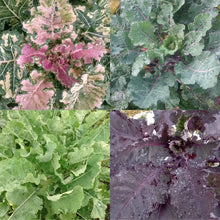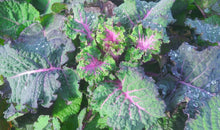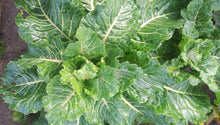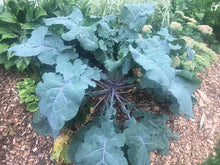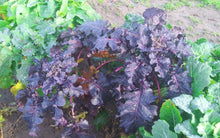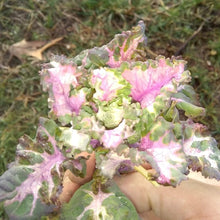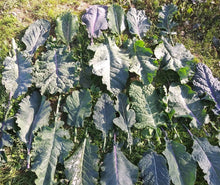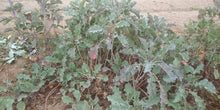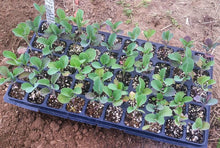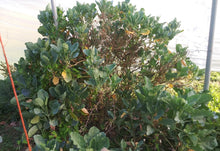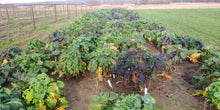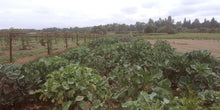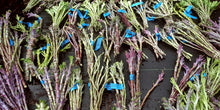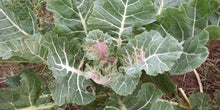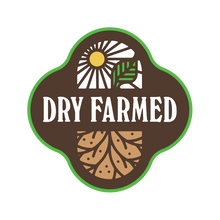'Homesteader's Kaleidoscopic Perennial' Kale Grex
Regular price
$5.00
Sale
Brassica oleracea var. ramosa
Origin: Oregon
Improvement status: Cultivar/Grex
Seeds per packet: ~85 ($5)
Bulk seeds per packet: ~225 ($12)
Germination tested 10/2025: 86%
Life cycle: Perennial
We're thrilled to once again be offering an updated population of this phenomenal kale from our good friend, the genius plant breeder Chris Homanics. Now, more than ever, we feel confident calling this a singular achievement in plant breeding and we have no doubt it will be the source of many fabulous perennial varieties in the future. Please stay in touch about the progress of your plants and any interesting specimens that crop up. Every seed in each packet has the potential to grow into a new and unique plant. How awesome is that?!
Here's what Chris himself has to say about these seeds:
"Perfect for the homesteader, the space-intensive gardener, permaculture food foresters, and market farmers alike! Grow kale as a perennial vegetable. These plants are literal bushes with many branches that grow an abundance of delicious greens throughout the year. Every plant is unique. A huge diversity of leaf shapes and colors. From long and thin to ruffled, smooth, flat, or wide. An array of colors — light green, red, dark purple, solid green, and more. After cold spells, some plants will even reveal a beautiful colorful variegation of pink or white in their leaves!
Why grow perennial kale? Homesteaders kale provides a year-round source of vital leafy greens. Its perenniality means those same plants will continue producing for a number of years, allowing the grower to create a multi-year rotation plan for their kale patch instead of replanting from seed each season. While most plants will flower, the vast majority will continue growing once flowering has finished later in the season. Due to its vigor, bushiness, and creeping habit, most plants get massive. I strongly recommend at least 3ft spacing. After several years, many plants will begin to decline, but your favorite plants can be kept alive indefinitely by cloning them. You can do that by taking stem cuttings of mature branches and then moving them to another part of the farm or garden. This practice is typically done from fall to early winter — depending on your climate.
Homesteaders is not only a great perennial kale, but also excellent in the kitchen. Being not just a farmer, but also comfortable in the kitchen and a lover of good food, this kale has been heavily selected towards superior flavor and a succulent texture. With both of the original bush kale parents being excellent epicurean varieties, selection was made to pass down their great flavor into this population. Repeated taste tests have found this kale grex to be a consistent top-performer — savored by chefs, CSA members, and farmers market customers alike.
Perennial kale is not just a great leafy vegetable for humans, but also can be important in providing a staple dietary component to your livestock like chickens, cows, sheep, goats, pigs, and more. It once played an important role in the animal stockyard and should again. Consider using this plant as a forage crop in paddock systems or agroforestry silvopasture systems as well. Plants hold up well to rotational grazing or can be cut and brought to livestock.
—---
How did this project come to be? The bedrock of this project was provided by two historic perennial tree kales that seldom flower, ‘Purple Tree Collards’ and ‘Daubenton’. The story is complicated, but these kales were crossed to each other and other Pacific Northwest & West Coast perennial kales as well as a variety of other Brassica oleracea including Baltic Red Kale, Brassica oleracea montana, Brussels sprouts, kohlrabi, Red Cavalier Kale, savoy cabbage, Spis Bladene, Walking Stick Kale, and more. Their progeny have been inter-crossed, reselected, cloned, isolated, reselected, interbred — many times now since 2011. This process forms a grex. What is a ‘grex’ you may ask? Grex in Latin means ‘flock’ and originally comes from the orchid hybridization world. It essentially means a genetically diverse interbreeding mix. An apt moniker for seed stewardship generally, as we are shepherds who herd seeds forward into the world.
Since 2011, this grex has been extensively selected from thousands and thousands of plants to guide this diverse population toward a strongly perennial and bushy growth habit. Other rigorous selection considerations have been made as well. Drought resistance and dry-farm compatibility is very important to me, especially in a dramatically changing climate. In fact, this kale performs very well in many drier climates. True to form, this seed has been produced in dry farm conditions with no supplemental irrigation. Winter hardiness and the ability to grow this in colder zones has been an important consideration for those who live in the north. After careful testing and feedback from other growers, we can confidently say this grex is hardy down to US zone 6, though there are folks pushing the limit in colder zones with good success. I have continued to make progress selecting for disease and insect resistance as well.
Since the initial public release in 2017, I’ve been hard at work carefully selecting and breeding this kale further toward these goals. I believe you will be very pleased with this work. In fact, in 2019 I began a whole new mass reselection of around 27,000 initial seedlings in 72 count trays. These included seeds from all my best lines. While still in-tray, these nascent seedlings were exposed to harsh heat and drought conditions of the summer and exposed to temperatures in the low teens during the winter. In 2020, the best surviving plants were carefully selected and transplanted into 4 inch pots to grow on. In July of 2020, plants that still had not flowered were selected again and around 650 plants were planted in an isolated field. Interspersed in that field were superior plants I’ve been cloning and keeping alive since 2013. In February 2021, field plants were screened for bushiness, vigor, general disease resistance, towards a more uniform leaf size, towards higher color content in leaves, and against the heaviest flowering plants. Approximately 540 plants remained to flower out. I managed to get both ‘Purple Tree Collards’ and ‘Daubenton’ to flower out in this patch, so your seed will contain direct backcrosses to those tree kales. Even after all this, about 7% of the plants did not flower at all! In September 2021, 66 plants were cloned out into the nursery for the next round of crossing to double down on the best traits. Stay tuned for another paradigm shift of what is possible with perennial kale!
Finally, an acknowledgement. The nucleus for this project began as an initial chance cross which was a mix of luck and forethought by my friend Graham from Wales. Having communicated about perennial kale for years, he was generous enough to send me some initial precious seed.
In the collaborative spirit of the small community working with perennial kales, this seed is being released under the OSSI [Open Source Seed Initiative] license* to protect this important genetic material from large multinational seed conglomerates that might seek to patent or otherwise control it. So, select out your favorite unique perennial kales and share with friends. Please continue to stay in touch: I always enjoy seeing photos of what develops from your work with this seed. I continue to accept seed or cuttings back of exceptional plants to include in my breeding population.
For more background information about this perennial kale, future availability of superior selected cloned plants, or to get involved in the collaborative breeding project, please check out the *Perennial Kale Breeding Project* on the EFN webpage (https://www.experimentalfarmnetwork.org/project/14) or follow me on Instagram at @headhandsandheart
As required by the Oregon Department of Agriculture and the Washington Crucifer Seed Quarantine, a representative sample of this seed was tested (by Oregon State University) and found to be free from Blackleg fungus (Leptosphaeria maculans or Phoma lingam).
* The Open Source Seed Initiative (OSSI) pledge states: “You have the freedom to use these OSSI-Pledged seeds in any way you choose. In return, you pledge not to restrict other's use of these seeds or their derivatives by patents or other means, and to include this pledge with any transfer of these seeds or their derivatives.” More information on OSSI can be found at osseeds.org.
















